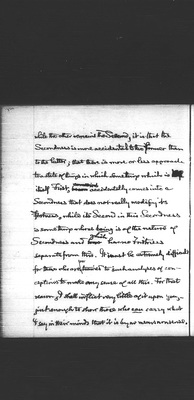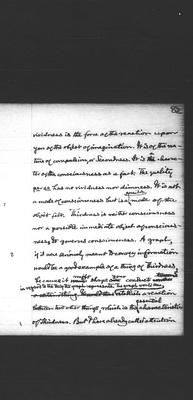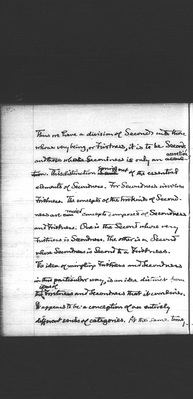Pages
51
while the other remains the Second, it is that the Secondness is more accidental to the former than to the latter; that there is more or less approach to a state of things in which something, which is itself First, accidentally comes into a Secondness that does not really modify its Firstness, while its Second in this Secondness is something whose being is of the nature of Secondness and which has no Firstness separate from this. It must be extremely difficult for those who are untrained to such analyses of conceptions to make any sense of all this. For that reason, I shall inflict very little of it upon you,— just enough to show those who can carry what I say in their minds that it is by no means nonsense.
52
82
vividness is the force of the reaction upon you of the object of imagination. It is of the nature of compulsion, or Secondness. It is a character of the consciousness as a fact. The quality per se has no vividness nor dimness. It is not a mode of consciousness but is a possible mode of the object felt. Thirdness is neither consciousness nor a possible immediate object of consciousness. It governs consciousness. A graph, if it were seriously meant to convey information would be a good example of a thing of Thirdness, because it might shape your conduct toward a certain thing. It would thus in regard to the thing the graph represents. The graph would thus establish a reaction between two other things, which is the essential characteristic of Thirdness. But I have already called attention
53
The extreme case kind of Secondness which I have just described is the relation of a quality to the matter in which that quality inheres. The mode of being of the quality is that of Firstness. That is to say, it is a possibility. It is related to the matter accidentally; and this relation does not change the quality at all, except that it imparts existence, that is to say, this very relation of inherence, to it. But the matter, on the other hand, has no being at all except the being that a subject of qualities. This relation of really having qualities constitutes its existence. But if all its qualities were to be taken away, and it were to be left quality-less matter, it not only would not exist, but it would not have any positive definite possibility,— such as an unembodied quality has. It would be nothing, at all.
54
84
to the distinction between a graph and a graph-replica. Your consciousness at a given moment may be a graph-replica. But the graph itself can never come into your mind except by the mediation of a replica.
We can seldom find any phenomenon in which one of the categories is so predominant as to improve our notion of the category. One might expect to find them illustrated by our apprehension of past, present, and future time. But the past and present appear under aspects too various. One might say that the past as a whole is what it is in itself, which is a Firstness, while the present has no other being or at least is not otherwise known to us, than as the last bit of the past. But the whole Time rather illustrates Thirdness. The Future, at any rate, which is able to bring about what never will be capable of having been brought about,
55
Thus we have a division of Seconds into those whose very being, or Firstness, it is to be Seconds, and those whose Secondness is only an accretion. This distinction springs out of the essential elements of Secondness. For Secondness involves Firstness. The concepts of the two kinds of Secondness are mixed concepts composed of Secondness and Firstness. One is the Second whose very Firstness is Secondness. The other is a Second whose Secondness is Second to a Firstness. The idea of mingling Firstness and Secondness in this particular way is an idea distinct from the ideas of Firstness and Secondness that it combines. It appears to be a conception of an entirely different series of categories. At the same time,




